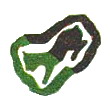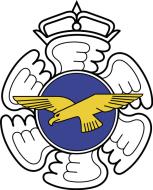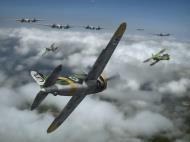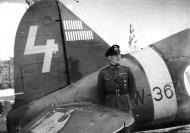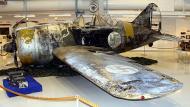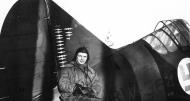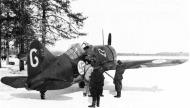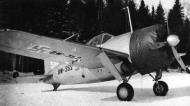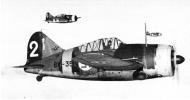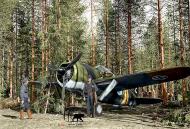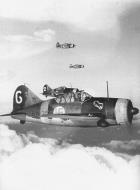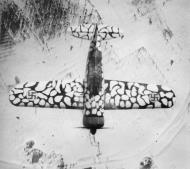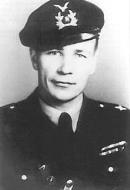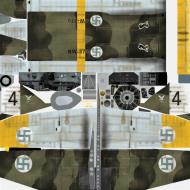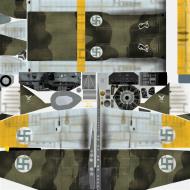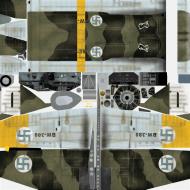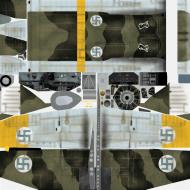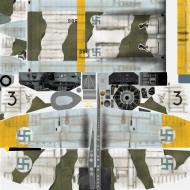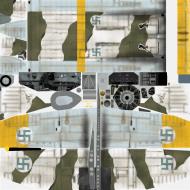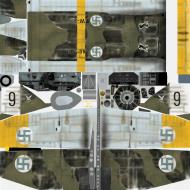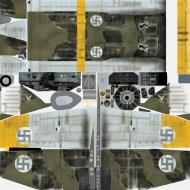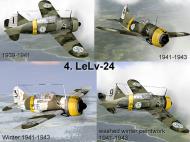Brewster MkI Buffalo FAF 1./LeLv24 BW371 Finland
Brewster MkI Buffalo FAF 2./LeLv24 BW352 Finland
Brewster MkI Buffalo FAF 2./LeLv24 BW355 Finland
Finnish company Nokia donated sufficient funds for the FAF to purchase a B-239. In return, the word NOKA was inscribed on BW-355. Operated by No. 24 Squadron, it was destroyed on 24 October 1944.[24] Future ace Paavo Mellin shot down an I-16 and shared in the destruction of a MiG-3 whilst flying this aircraft.[25]
Brewster MkI Buffalo FAF 4./LeLv-24 BW364 flown by Finish Ace Ilmari Juutilainen Finland 1939
Brewster MkI Buffalo FAF 4./LeLv-24 BW358 Finland 1939
Brewster MkI Buffalo FAF 4./LeLv-24 BW370 Finland 1939
Brewster MkI Buffalo FAF 4./LeLv-24 BW372 Finland 1939
Brewster MkI Buffalo FAF 4./LeLv-24 BW372 Finland 1939
Brewster MkI Buffalo FAF 4./LeLv-24 BW380 Finland 1939
Brewster MkI Buffalo FAF 4./LeLv-24 BW384 flown by Ens L. Nissinen a Finnish Ace ended up with 22 and a half victories flying the Brewster Model 239 Finland
Brewster MkI Buffalo FAF 4./LeLv-24 BW386 Finland 1939
Brewster MkI Buffalo FAF 4./LeLv-24 BW393 Finland 1939
Profile 00:
Continuation War 1941-44
The Finnish Air Force was prepared better for the Continuation War, with 550 planes, though many were considered second-rate and thus "exportable" by their countries of origin. Finland purchased a large number of aircraft during the Winter War, but few of those reached service during the short conflict. Politics also played a factor, since Hitler did not wish to antagonize the Soviet Union by allowing aircraft exports through German-controlled territory during the conflict. New aircraft types were in place by the time hostilities with Russia resumed in 1941. Small numbers of Hawker Hurricanes arrived from England, Morane-Saulnier M.S.406s from France, Fiat G.50s from Italy, a few dozen Curtiss Hawk 75s captured by the Germans in France and Norway then sold to Finland, and numerous Brewster B239s from the neutral USA strengthened the FiAF. The FiAF proved capable of holding its own in the upcoming battles with the Red Air Force. Older models, like the Fokker D.XXI and Gloster Gladiator, were replaced in front-line combat units with the new aircraft.
The FiAF's main mission was to achieve air superiority over Finland and prevent Soviet air power from reinforcing their front lines. The fighter squadrons were very successful in the Finnish offensive of 1941. A stripped-down, more maneuverable, and significantly lightened version of the American Brewster B239 "Buffalo" was the FiAF's main fighter until 1943. Results with this fighter were very good, even though the type was considered to be a failure in the US Navy & with British Far East forces. In the Finnish use, the Brewster had a victory rate of 32:1 - 459 kills while losing only 15. German Bf 109s replaced the B239 as the primary front-line fighter of the FiAF in 1943, though the Buffalos continued in secondary roles until the end. Other types, especially the Italian Fiat G.50 and Curtiss Hawk 75 also proved capable in the hands of well-trained Finnish pilots. Various Russian designs also saw action when lightly-damaged "kills" were repaired and made airworthy.
Dornier 17s (received as a gift from Hermann Goring in 1942) and Junkers 88s gave more capacity to the bombing capability of the Finnish Air Force. The bomber units flew assorted missions with varying results, but a large part of their time was spent in training. Thus the bomber squadrons of Flying Regiment 4 were ready for the summer battles of 1944, which included for example the Battle of Tali-Ihantala.
While the FiAF was successful in its mission, the conditions were not easy. Spare parts for the FiAF planes were scarce -- parts from the US (Buffalo & Hawk), Britain (Hurricanes), and Italy (G.50) were unavailable for much of the war. Repairs took often a long time, and the State Aircraft Factory was burdened with restoration/repair of Soviet war booty planes, foreign aircraft with many hours of flight time, and the development of indigenous Finnish fighter types.
Finland was required to expel or intern remaining German forces as part of its peace agreement with the Soviets in mid-1944. As a result, the final air battles are against the retreating Luftwaffe.
The Finnish Air Force did not bomb any civilian targets during either war. Curiously, overflying Soviet towns and bases was also forbidden, as to avoid any unneeded provocations and to spare equipment.
The Finnish Air Force shot down 1621 Soviet air planes while losing 210 own planes during the Continuation war 1941-44 according to Kalevi Keskinen and Kari Stenman's book "Aerial Victories 1-2".
Finnish Air Force, Suomen ilmavoimat, Finska flygvapnet
Active: March 6, 1918-present
Country: Finland
Role: Air defence
Size: 3,100 personnel, 38,000 personnel mobilized
Motto: Qualitas Potentia Nostra, "Quality is our Strength"
Engagements: Finnish Civil War, Winter War, Continuation War
Commanders
Commander: Lieutenant General Heikki LyytinenThe Finnish Air Force (FAF) (Finnish: Ilmavoimat, Swedish: Flygvapnet) is one of the branches of the Finnish Defence Forces. Its peacetime tasks are airspace surveillance, identification flights, and production of readiness formations for wartime conditions. As a separate branch of the military, the Finnish Air Force is one of the oldest in the world, having existed officially since 6 March 1918.
History
During the Finnish Civil War, the Whites had to rely on foreign pilots and aircraft. The official and neutral Sweden refused to send men and material, but individual Swedish citizens wanted to help the Whites. The editor of the Swedish daily magazine Aftonbladet, Waldemar Langlet, bought a N.A.B. Albatros aircraft from the Nordiska Aviatik A.B. factory with funds gathered by the Finlands vanner ("Finland's friends") organization. This was the first aircraft to arrive from Sweden. It was flown via Haparanda on 25 February 1918 by the Swedish pilots John-Allan Hygerth (who became the first commander of the Finnish Air Force on 10 March) and Per Svanback. The aircraft made a stop at Kokkola and had to make a forced landing in Jakobstad when the engine broke down. This aircraft was later given the designation F.2 in the Finnish Air Force ("F" came from the Swedish word "Flygmaskin" (aircraft)).
The Swedish count Eric von Rosen gave the Finnish White government its second aircraft, a Thulin Typ D. A photograph of this plane can be found in the book by Christopher Shores. The pilot, Lieutenant Nils Kindberg, flew the aircraft to Vaasa on 6 March 1918, having von Rosen as a passenger. As this aircraft was given against the will of the Swedish government, and no flight permit had been given, it resulted in a 100 kronor fine for Kindberg for leaving the country without permission. This aircraft is considered by some to be the first aircraft of the Finnish Air Force, since the Finnish Air Force didn't exist during the Civil War, and since it was only the Red side who flew a few aircraft with the help of some Russian pilots. The von Rosen aircraft was given the designation F.1. The air force was officially called the "aviation force" during its first years. The Finnish Air Force is one of the oldest air forces of the world - the RAF was founded as an independent branch on 1 April, 1918 and the Swedish Flygvapnet in 1925.
Von Rosen had painted his personal good luck charm on the Thulin Typ D aircraft. This charm - a blue swastika, the ancient symbol of good luck - was adopted as the insignia of the Finnish Air Force. The white circular background was created when the Finns tried to paint over the advertisement from the Thulin air academy advertisement. The swastika was officially taken into use after an order by Mannerheim on 18 March 1918. The FAF had to change the swastika insignia after 1945, due to an allied control commission decree, where all swastikas had to be abandoned. However, the original swastika can still be found in some regimental flags and medals, especially in the air force.
The F.1 aircraft was destroyed in an accident, killing its crew, not long after it had been handed over to the Finns. On 7 September 1920, two newly purchased Savoia flying boats crashed in the Swiss Alps en route to Finland, killing all on-board (three Finns and one Italian). This day has since then been the memorial day for pilots that have been lost.
The Finnish Air Force assigns the matriculation numbers to its aircraft by assigning each type a two-letter code following by dash and an individual aircraft number. The two-letter code refers to the aircraft type name, such as HN for F/A-18 Hornet, DK for Saab J-35 Draken, VN for Valmet Vinka etc.
Winter War 1939-40
The Winter War began on November 30, 1939, when Soviet Air Force bombed 21 Finnish cities and municipalities. The Soviet Union is estimated to have had about 5,000 airplanes in 1939, and of these, some 700 fighters and 800 medium bombers were brought to the Finnish front to support the Red Army's operations. As with most aerial bombardment of the early stages of WW2, the damage against Finnish industry and railways was very limited.
The Finnish Air Force was equipped with 17 bombers and 31 fighters at the beginning of the Winter War. There were 54 liaison aircraft but 20 of these were only used for messengers. The most modern aircraft in the Finnish arsenal were the British-designed Bristol Blenheim bombers that had been license-built in Finland. The primary fighter aircraft was the Fokker D.XXI, a cheap but maneuverable design with fabric-covered fuselage and fixed landing gear. On paper, this force should have been no match for the attacking Soviet Red Air Force.
In order to prevent their aircraft from being destroyed on the ground similar destruction, the Finns spread out their aircraft to many different airfields and hid them in the nearby forests. The Finns constructed many decoys and built shrapnel protection walls for the aircraft. Soviet air raids on Finnish airfields usually caused little or no damage as a result, and often resulted in interception of the attackers by the Finns as the bombers flew homeward.
As the war progressed, the Finns tried desperately to find aircraft wherever there were any to be purchased. This policy resulted in a very diverse aircraft inventory, which was to cause some major logistical problems until the inventory became more standardized. The Finnish Air Force was to consist of numerous American, British, Czechoslovakian, Dutch, French, German, Italian, Soviet, and Swedish designs. Other countries, like South Africa and Denmark, sent aircraft as gifts. Many of these purchases and gifts didn't arrive until the end of the hostilities, but were to see action later during the Continuation and Lapland wars.
The Finnish Air Force shot down 218 Soviet aircraft during the Winter War while losing only 47 to enemy fire. The Finnish anti-aircraft is also said to have shot down 314 enemy planes. 30 Soviet planes were captured -- "kills" that landed more or less intact within Finland and were quickly repaired.
The Finnish Air Force FAF
A HISTORICAL REVIEW
By Lt Gen (FAF ret) Heikki Nikunen
The Finnish Air Force was founded on 6th March 1918. There was one exceptional feature in the founding of the FAF, that it was organized right from the start as an independent branch of the armed forces. This foresight created a good basis for its development and made it one of the oldest air forces in the world.
The first aircraft was donated by a Swedish count, Erik von Rosen. On the wings of the airplane was painted his personal lucky insignia, the blue swastikas. This was the origin of the first official Finnish Air Force markings. The swastikas, still seen in many FAF traditional markings, as insignias have nothing to do with the nazi swastikas of the 1930s.
The Winter War was the first real baptism of fire for the Finnish Air Force. The Soviet Union and Nazi Germany formed a pact in 1939 which resulted in the German attack on Poland in September of that year. Subsequent to that assault was the Soviet Union's attack on Finland on November of the same year.
The Defense Forces of Finland was ill-prepared for the war from a material standpoint. In the Air Force for example the number of fighters was alarmingly small. However, their training and therefore their combat readiness was fairly high. Actually, The Finnish Air Force was the inventor of the modern fighter tactics.
Before and in the beginning of the second World War the ideas of general Douhet were noticed in many air forces and accordingly the fighter forces were rather universally underestimated. Fighter tactics also was hampered by peace time formalities.
In Great Britain the two types of fighter formation were either built up from a tight vic of three aircraft or four in line-astern. The vic was a legacy of peace time flying in which the two wingmen had all their work cut out to stay near their leader and little time to search the sky. The high casualty rate of the tail-end Charlies was a grim measure of the vulnerability of the line-astern formations. During the Battle of Britain the RAF renewed both its formation tactics and training.
In Germany the Luftwaffe was founded again in 1933 and the Chief of the Luftwaffe General Staff, general Wever, emphasized strategic bombers as the main aircraft of the new organization. After Wever had died in the flight accident in 1936 the new technical chief, Ernst Udet, brought from a trip to USA the idea of dive bombers as the most suitable method for the blitzkrieg philosophy. The German bi-plane fighters, Arado Ar 65/68 and Heinkel He 51, used in the Spanish Civil War, proved to be inferior compared to the adversaries I-15 and I-16 from Soviet Union. However, in 1938 both the fighters and the fighter tactics in Luftwaffe were renewed when Legion Condor got the new Bf 109 B-2 fighters in use.
In the Soviet Union the bombers had the priority in the operational planning of the air forces during the 1930s. Also the Soviet Union participated the Spanish Civil War but its Air Force elements were used as the subordinated support units to the Army and thus for example the fighter tactical lessons were unlearned. The Soviets kept on using the tight three fighters formation as the basic tactical element in air combat and the wingmen were to fire anytime the leader did so. The weapons were lined straight ahead.
Some of the first American fighter combat experiences came via Flying Tigers in China. They started by using eight fighters tight formation but canceled it soon and changed both tactics and training. Also Japanese first used rather big formations, for example fifteen Mitsubishi 96 Claude fighters in tight Vic-formation in their Chinese campaign.
In Finland the Air Force started during the years 1934 and 1935 to use the loose and broad section as the basic formation in fighter aviation. The bigger formations were built so that two sections flying side by side made a finger four division. In a flight formation two divisions flew almost side by side while the top division was much higher than the lower strike division. In divisions, the sections still operated independently. These formations, at that time differing from all international principles, were developed during fighter courses in both theoretical analyses and practical exercises.
The Finnish fighter pilots concluded that they would never have such big numbers of fighters that they could build up those great squadron formations which were used abroad to concentrate fighter power to certain areas. They also concluded that big and tight fighter formations were tactically inefficient.
The most important element in the fighter combat was surprise, and that was the goal which always had to be tried to reach for. A big and tight formation could very seldom achieve the surprise because it was easily seen from far away and the pilots couldn't keep good lookout while working to maintain their positions in the formation. On the other hand a section with the two fighters about 100 - 150 yards away from each other, or the division with 300 - 400 yards between the two sections, were found very effective in the search exercises. Every pilot was free to keep a good lookout to every direction and also all the time to check the six of the other pilots. In addition to that this kind of small and loose formation was seen much later because all of its aircraft were not always at the same time in the view of the opponent. The search phase was heavily emphasized in the training and the ability in that was an important factor in the evaluation of the fighter pilots.
When the aerial engagement began every pilot was free to maneuver in the most effective way, so, both the attacks and the evasive maneuvers could be done without any delays. The flying in the small formations meant continuous fighting against bigger numbers but this could be compensated by always attacking regardless of numbers. The fighter combat generally spread quite quickly into section fights and duels where there was no immediate benefit of the bigger numbers. In these separate combats the better pilots always won. However, this philosophy demanded that every pilot was a skillful air combatant. This skill was trained for both in the fighter courses and in the squadrons.
One of the corner stones in the skill of the fighter pilot was the complete control of his aircraft. This was trained by aerobatics and combat maneuvers, and also by intentional mismaneuvering. In the classic one versus one and two versus two exercises and in the practice attacks on bomber targets the combat maneuvers were trained as instinctive actions. In practical exercises the simple maneuvers were found to be the best ones.
It was also found in training that one of the most important skills of fighter pilot was the shooting accuracy; the ability to judge the right deflection during maneuvering, to estimate the right shooting distance and to concentrate the fire on the point target, for example on some vulnerable part of the target airplane. The shooting training became an essential, and in times dominating, part of the fighter training.
When the Winter War started the Finnish fighter tactics differed from almost all other countries` tactical principles. Only the Germans had started to use similar methods during the Spanish Civil War. There was no certainty of how this tactics would do in the merciless test of war. The numbers of the attacking Soviet Union seemed to be crushingly overwhelming. However, there was no hesitation about the defense task in the flying units. At least in that sense the training had succeeded; it had created a fighter pilot cadre with high motivation and self-confidence.
The war experiences proved both the tactics and the training to be right and as a result, the main fighters Fokker D.XXIs were able to achieve an exchange ratio (kills in air combat versus losses in air combat) of 16:1 against Soviet combat aircraft. This was spectacular considering that the Fokkers had fixed undercarriages, making them slow for the bomber interceptor missions and clumsy against fighters in aerial combat.
The Soviet order of battle in the Finnish campaign enjoyed a tenfold superiority against the Finnish Defence Forces. As a consequence Finland was forced to yield certain areas in Karelia. However, they were able to stop the Soviet offensive inflicting heavy losses on their enemy. The ineffectiveness of the Soviet offensive became an embarrassment to the Soviet superpower and they considered suing for a temporary peace agreement. On the other hand, Germany being hostile, official Sweden strictly neutral and the support plans of France and Great Britain proving to be inadequate, Finland had not resources enough to continue the fight alone. The peace treaty was thus signed on the evening of 12th March 1940 and came into effect the following day. This included a revision of the national border west of Lake Ladoga.
When the war started the lack of fighters was quickly realized within the nation at large, and prompt measures were initiated to increase the fighter force. Thus 92 fighters were purchased or received as donations during the Winter War, including Fiat G.50, Gloster Gladiator II and Morane Saulnier M.S. 406 types. The best fighter acquired during the war, a Brewster B 239, came too late to participate in combat missions, and the same applied to the 10 Hawker Hurricane I fighters. So, all in all, the Finnish fighter force was in much better shape in the end of the war than what it had been in the beginning of the war.
Finland's strategic position stayed difficult after the Winter War. The Soviet Union continued its diplomatic pressure and Foreign Minister Molotov, on a trip to Germany in November 1940, demanded that the "Finland problem" must be resolved for good. The supporters, France and Great Britain, were themselves embroiled in the war and in an ironic twist of fate, the Finns found that the only nearby country with whom they could trade to improve their defence status was the Soviet Union's former ally, Germany, which was at that time prepared its eastern offensive.
From a political point of view Finland did not want to be involved in an alliance with Nazi Germany, but from a military standpoint cooperation seemed to be the only possible solution. But despite numerous requests by Germany to advance their forces beyond the demarcation line drawn through Eastern Karelia, for an attack on Leningrad, the Finns refused to do this.
When Germany began its eastern offensive against the Soviet Union in June 1941, Finland had already given that country permission to stage units through Lapland, and after Soviet bombers had attacked various targets in Finland on 25th June 1941, the Finns officially entered into military cooperation with Germany, marking the beginning of the Continuation War.
At the beginning of the Continuation War the Soviet forces enjoyed only a two-to-one superiority over the Finns, and this permitted the Finns to advance fairly quickly to establish a defensive line where trench warfare network were ultimately located. The FAF had about 120 fighters in its flying units at that time, including Brewsters (BW), Fiats (FA), Morane Saulniers (MS), Curtisses (CU) and some Hurricanes (HC), 21 bombers, mainly Blenheims (BL) and some war booty planes, and 58 reconnaissance and liaison planes of various types, mainly obsolete. During this initial phase of the campaign the FAF achieved air superiority, and the Brewsters in particular excelled themselves, achieving a remarkable exchange ratio of 32:1. They added to the Winter War formation tactics and shooting accuracy a vertical energy-speed maneuver which was very effective against their main adversaries of that time, the I-153 Chaikas and I-16 Ratas, which were more agile but a little slower.
During the trench war period the most important air operations were carried out in the Gulf of Finland. These were partly the outcome of naval operations, and gradually the process evolved into the Battle of the Gulf of Finland, which culminated in Soviet air raids on Kotka and Helsinki. Finnish fighter pilots carried the main defensive burden in this battle, and were quite successful in this. The FAF strategy of concentrating on aerial combat instead of attacks on the well-defended enemy bases proved correct. The numbers of enemy aircraft destroyed on the ground didn't mean much because the Soviet superpower's own aircraft production plus lend-lease support from Great Britain and the United States meant that there was no shortage of aircraft. The shortage of trained pilots, however, became a problem for the Soviets, as became apparent in the final phase of the Battle of the Gulf of Finland. After the major aerial engagements of May 1944, the People's Commissar for the Navy, Admiral N. G. Kutznetsov, had to withdraw a whole regiment from front line duties because of the lack of pilots.
When the tide of war changed and the German forces began to retreat westwards, Soviet pressure on Finland increased. In spring of 1944 the Soviets decided to take Finland before beginning their advance towards Berlin. They amassed a tenfold superiority in troops and aircraft on the Karelian Isthmus and began their strategic offensive on 9th June 1944. Their advance achieved initial success, forcing the withdrawal of Finnish forces along the Isthmus, but in July 1944 the Finns were able to stabilize the front at the Vuoksi River and further attempts by the Soviet forces to advance beyond this line were repelled. The process seen in the Winter War was repeated.
Despite the Soviet superiority in numbers of aircraft, the FAF was able to concentrate its air forces and continue to achieve good results. The Brewsters, along with the Morane, Fiat and Curtiss fighters, although continuing their operations, became obsolete in terms of performance from 1943 on, and new fighters, Messerschmitt 109 G (MT)s, were received, although once again only in small numbers. When the Soviet offensive began, the units had about 40 Messerschmitts. Fortunately, the FAF was able to get 74 more fighters from Germany during the campaign, so that despite the fierce battles, the number of Messerschmitt fighters actually increased during the summer of 1944. The number of bombers in the flying units at the beginning of June 1944 was 66.
One good example of the ability to achieve local and temporal air superiority was the fact that the FAF bombers and a German support unit known as Kuhlmey were able to continue their effective air raids, which were vital contributions to the war effort, as the bombings could be concentrated on Soviet massed troops just before their preplanned attack times. Warnings of impending troop movements were usually captured by radio intelligence. It is also significant that no bombers in the formations escorted by the Messerschmitts were lost to enemy fighters during this period. The Messerschmitt fighters achieved an exchange ratio of 25:1.
Again the Finnish fighter force was stronger in the end of the war than it had been in the beginning of that. Also, during the wars the number of Finnish fighter aces had become a world record in relation to population. And almost all the Finnish top aces were fighting at the end of the war just as they had been at the beginning.
Also the bomber and reconnaissance units were able to carry on their missions throughout.
When it became obvious that the Soviets had failed in their plan to take Finland, they began to move their troops from the Karelian front for the race to Berlin. This failure on the Karelian Front was the only Soviet strategic defeat during their advance westward. The Soviets signed a temporary peace agreement with the Finns on 4th September 1944 with the stipulation that the Finns push the cooperative German forces out of Lapland.
Furthermore, the Finns ceded certain areas in Karelia and Petsamo and retired to the 1940 border. Nevertheless, the results of both the Winter War and the Continuation War were considered major victories for Finland. From the opening shots of the Winter War to the end of the Continuation War the Finnish objective was to save Finland and guarantee her independence. This was done and also one interesting point was made. Of all the countries in the European theater participating the Second World War there were only two which never were occupied: Finland and Great Britain.
Brewster MkI Buffalo FAF LeLv-24.4 mixed black and white photographs Finland
Brewster Buffalo MkI FAF LeLv24.2 BW354 over Lake Tikshozero Finland 1942
Brewster Buffalo MkI FAF LeLv24.2 BW354 over Lake Tikshozero Finland 1942 ref: http://www.flickr.com/ tormentor4555
Brewster Buffalo MkI FAF showing its camouflage Finland 1942
Finnish fighter "Brewster B-239 from (3/LeLv 24) Squadron in winter camouflage near Suulajarvi in Finland February 1943. The Brewster F2A Buffalo was an American fighter aircraft which saw limited service early in World War II. It was one of the first U.S. World War II monoplanes with an arrestor hook and other modifications for aircraft carriers. The Buffalo won a competition against the Grumman F4F Wildcat in 1939 to become the U.S. Navy's first monoplane fighter aircraft. Although superior to the Grumman F3F biplane it replaced, the Buffalo turned out to be a disappointment. en.wikipedia.org/wiki/Brewster_F2A_Buffalo
Several nations, including Finland, Belgium, Britain and the Netherlands, ordered the Buffalo. Of all the users, only the Finns seemed to find their Buffalos effective, flying them in combat against early Soviet fighters with excellent results,as opposed to the far more advanced Japanese fighters that the other nations faced.
Finland Map
Bibliography:
Magazine References: +
- Airfix Magazines (English) - http://www.airfix.com/
- Avions (French) - http://www.aerostories.org/~aerobiblio/rubrique10.html
- FlyPast (English) - http://www.flypast.com/
- Flugzeug Publikations GmbH (German) - http://vdmedien.com/flugzeug-publikations-gmbh-hersteller_verlag-vdm-heinz-nickel-33.html
- Flugzeug Classic (German) - http://www.flugzeugclassic.de/
- Klassiker (German) - http://shop.flugrevue.de/abo/klassiker-der-luftfahrt
- Le Fana de L'Aviation (French) - http://boutique.editions-lariviere.fr/site/abonnement-le-fana-de-l-aviation-626-4-6.html
- Le Fana de L'Aviation (French) - http://www.pdfmagazines.org/tags/Le+Fana+De+L+Aviation/
- Osprey (English) - http://www.ospreypublishing.com/
- Revi Magazines (Czech) - http://www.revi.cz/
Web References: +
- History of RAF Organisation: http://www.rafweb.org
- Wikipedia, the free encyclopedia: http://en.wikipedia.org/
 Editor for Asisbiz: Matthew Laird Acred
Send Mail
Editor for Asisbiz: Matthew Laird Acred
Send Mail
Please help us to improve these articles with any additional information or photo's.
If you should encounter any bugs broken links, or display errors just email us.
If you love our website please add a like on facebook or follow us on Google+
Please donate so we can make this site even better !!

